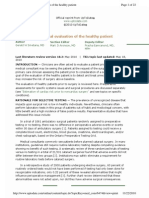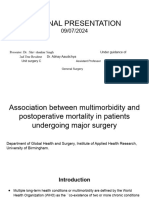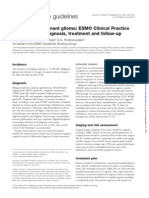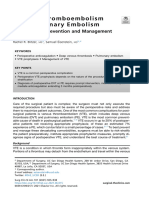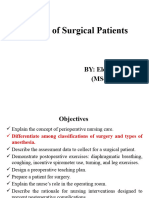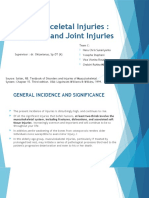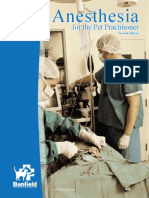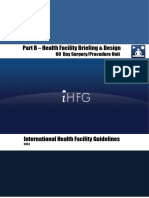CC 11904
CC 11904
Uploaded by
ikjaya3110Copyright:
Available Formats
CC 11904
CC 11904
Uploaded by
ikjaya3110Original Title
Copyright
Available Formats
Share this document
Did you find this document useful?
Is this content inappropriate?
Copyright:
Available Formats
CC 11904
CC 11904
Uploaded by
ikjaya3110Copyright:
Available Formats
Shah and Hamilton Critical Care 2013, 17:226
http://ccforum.com/content/17/3/226
REVIEW
Clinical review: Can we predict which patients are
at risk of complications following surgery?
Nirav Shah* and Mark Hamilton
Abstract
There are a vast number of operations carried out
every year, with a small proportion of patients being
at highest risk of mortality and morbidity. There has
been considerable work to try and identify these
high-risk patients. In this paper, we look in detail at
the commonly used perioperative risk prediction
models. Finally, we will be looking at the evolution
and evidence for functional assessment and the
National Surgical Quality Improvement Program (in the
USA), both topical and exciting areas of perioperative
prediction.
Introduction
There are an estimated 234 million surgical operations
every year worldwide [1], of which 4.2million operations
are carried out in England [2]. A precise estimation of
perioperative complications and postoperative morbidity
is dicult to gain, but it has been suggested this may
occur in between 3 and 17% of cases [3,4]. This wide
range in reported complications is probably related to
variable reporting, as well as disputed classication of
complications. These complications cover a range of
organ systems, including gastrointestinal, infectious, pulmonary, renal, haematological and cardiovascular [5,6].
These complications can be anaesthetic related (for
example, postoperative nausea and vomiting or hypoxaemia in the recovery room) or surgical (for example,
wound related, ileus or haemorrhage).
Postoperative mortality across all procedures is
approximately 0.5%, although it may exceed 12% in older
patients undergoing emergency surgery in the UK [7]. A
small high-risk group of patients has been shown to be
responsible for approximately 83% of deaths and
signicantly longer hospital stays, despite making up only
*Correspondence: niravken@gmail.com
General Intensive Care Unit, St Georges Hospital, Blackshaw Road, Tooting,
London, SW17 0QT, UK
2010 BioMed Central Ltd
2013 BioMed Central Ltd
12.5% of hospital admissions for surgery [7]. Of note,
almost 90% of the patients in this high-risk group had
emergency surgery, but <15% of them were admitted to
critical care directly from the operating theatre.
Comparatively, cardiac surgery in traditionally high-risk
patients will routinely admit the majority of its patients
to critical care postoperatively. Cardiac surgery has
openly published mortality rates for a number of years.
These rates have demonstrated a steady improvement,
with a typical mortality rate of <2 to 3% [8].
Ideally, we would like to identify the patients who are
most likely to suer postoperative complications or
mortality both to inform the decision to operate, and to
target postoperative care and critical care provision for
these patients. Unfortunately, outcomes for patients
undergoing surgery currently vary widely, and (particularly emergency) surgical care is often disjointed and may
not be appropriately patient centred [9].
Complications
Accurate gures for surgical complication rates are
dicult to obtain because of the lack of consensus
amongst surgeons on what constitutes a postoperative
complication. This diculty is further exacerbated by
disagreement on a structured classication of postoperative complications and morbidity, making it dicult
to compare dierent surgical techniques or predictive
models for surgical complications. In 1992 a model for
classication of surgical complications was proposed by
Clavien and colleagues [10]. Uptake of this model of
classication was slow, due in part to a lack of evidence of
international validation. The model was updated in 2004,
and evaluated in a large cohort of patients by an
international survey. This new model allows grading of
postoperative complications, regardless of the initial
surgery. The dierent categories are broad, permitting
clear placement of complications in the various grades
(Table1).
To accurately record postoperative complications, it is
important to have a validated questionnaire. The Postoperative Morbidity Survey is one such questionnaire
[5,11]. This survey is well-validated and provides objective evidence of postoperative complications, tting the
Shah and Hamilton Critical Care 2013, 17:226
http://ccforum.com/content/17/3/226
Page 2 of 8
Table 1. Classification of surgical complications
Grade
Description
Minor complication that can be easily treated on the ward with simple procedures or medications (for example, intravenous catheter,
nasogastric tube, anti-emetic, simple analgesic)
Postoperative transfusion or treatment with medications other than those simple agents permitted under grade 1
3a
Needing invasive therapy either surgical, endoscopic or radiological without general anaesthesia
3b
Needing invasive therapy either surgical, endoscopic or radiological with general anaesthesia
4a
Single-organ dysfunction requiring high-dependency unit/ICU admission
4b
Multiorgan dysfunction requiring high-dependency unit/ICU admission
Death
Suffix d
Added if the patient is suffering from a complication at discharge
Adapted from [11].
classication described above, and has been validated in
a UK population [6] (Tables2 and 3).
complications. Part of this response would include
appropriate early use of critical care facilities.
Guidelines
There are a number of guidelines available to both aid in
the identication of and guide the care of the high-risk
patient.
In 2010 the Association of Anaesthetists of Great
Britain and Ireland published guidelines on the preoperative assessment of a patient having an anaesthetic [12].
This document encourages a formal preoperative
assessment process, which should start the process of
identifying high-risk patients, as well as preparing the
patient for their anaesthetic. These guidelines incorporate
the guidelines issued by the National Institute for Clinical
Excellence in 2003 on the use of routine preoperative
tests for elective surgery [13].
The American Heart Association published guidelines
on perioperative cardiovascular evaluation and care for
noncardiac surgery in 2007 [14]. These were updated in
2009 to incorporate new evidence relating to perioperative -blockade [15]. Similar guidelines were also
issued by the European Society of Cardiology and
endorsed by the European Society of Anesthesiology in
2009 [16]. One important predictive element suggested
by the guidelines is the use of metabolic equivalents
(METs): 1MET is the oxygen consumption of a 40-yearold, 70 kg man, and is approximately 3.5 ml/minute/kg.
Patients unable to reach 4 METS (equivalent of climbing
a ight of stairs) are suggested to be at increased risk
during surgery [17].
The Royal College of Surgeons of England and the
Department of Health have also set up a Working Group
on the Peri-operative Care of the Higher Risk General
Surgical Patient, which has issued a set of guidelines on
the care of the high-risk surgical patient [9]. In addition
to the detection of complications following surgery, these
guidelines emphasise the importance of a rapid, appropriate response to limit the number and severity of
Risk prediction
Evidently it would be preferable to identify high-risk
patients prior to starting any operations. To make this
identication it is necessary to have an agreed denition
of what constitutes a high-risk patient. The Royal College
of Surgeons of England Working Group has dened a
high-risk patient as one with an estimated mortality 5%,
with consultant presence being encouraged if this value
exceeds 10%. The group go on to suggest that any patients
with estimated mortality >10% should be admitted to
critical care postoperatively.
To accurately estimate probable mortality and morbidity, we should ideally use an approach that combines
the patients physiological characteristics with the
procedure to be carried out to calculate a predictive risk.
The ideal risk prediction score should be simple, easily
reproducible, objective, applicable to all patients and
operations, and both sensitive and specic. Furthermore,
this score should be equally easily applied to both the
emergent and non-emergent patient and setting. Whilst
in the non-emergent setting the anaesthetist has access to
all of the patients investigations and to more elaborate
physiological investigations, the emergent scenario
requires decisions based on the acute physiological
condition and quick investigations. The two scenarios
can therefore be very dierent, and it may not be possible
to use one risk score for both emergent and nonemergent operations.
There are various risk scoring systems that have been
described in the literature. These systems can be classied as those estimating population risk or individual risk
[18,19]. Scores predicting individual risk can be general,
organ specic, or procedure specic. It is important not
to use population-based scoring systems in isolation to
make individual decisions because they cannot always be
extrapolated to specic patients.
Shah and Hamilton Critical Care 2013, 17:226
http://ccforum.com/content/17/3/226
Page 3 of 8
Table 2. Clinical examples of postoperative complications
Grade
Organ system
Example
Cardiac
Arrhythmia cardioconverting with electrolytes
Respiratory
Fluid overload requiring diuretics
Neurological
Mild delirium, self-limiting
3a
Gastrointestinal
Drug-related diarrhoea
Renal
Mild acute renal failure (not requiring treatment)
Cardiac
Atrial fibrillation requiring -blockade/digoxin
Respiratory
Pneumonia needing antibiotics and/or oxygen
Neurological
Transient ischaemic attack
Gastrointestinal
Ileus needing nasogastric/further treatment
Renal
Urinary tract infection needing antibiotics
Cardiac
Bradyarrhythmia needing pacing wire
Respiratory
Effusion needing chest drain
Neurological
Extra/subdural haematoma needing evacuation
Gastrointestinal
Pseudo-obstruction needing flatus tube
Renal
3b
4a
Cardiac
Tachyarrhythmia needing direct current cardioversion
Respiratory
Bronchopleural fistula post thoracic surgery
Neurological
Extra/subdural haematoma needing evacuation
Gastrointestinal
Anastomic leakage needing surgery
Renal
Stenosis of ureters after transplantation
Cardiac
Heart failure requiring ionotropes
Respiratory
Pneumonia needing intubation
Neurological
Cerebrovascular accident/haemorrhage
Gastrointestinal
Pancreatitis
Renal
Acute renal failure
4b
Any combination of the above
Adapted from [11].
An example of a general score that is based on estimating population risk is the American Society of
Anesthetists (ASA) classication [20]. The ASA classication was not originally composed as a risk prediction
score, although it is often used as such. The dierent ASA
classes have been shown to be good predictors of
mortality [21], while the rate of postoperative morbidity
has also been noted to vary with class [22]. The ASA
system has the advantage of being a simple, easily applied
score, which is widely known. However, the ASA classication is subjective and does not provide individual or
procedure specic information. The system has also been
shown to have poor sensitivity and specicity for
individual patient morbidity and mortality [23].
The Charlson Comorbidity Index is a generic score
based on weighting various preoperative diseases and
predicting long-term survival [24]. This score is relatively
simple to use, but also does not take into account the
surgical operation, and relies on a subjective assessment
of the patient, which may lead to errors. As such, it tends
to be used as a research tool rather than in daily clinical
practice [25].
In 1999 Lee and colleagues published a Revised Cardiac
Risk Index [26]. This index is a scoring system used solely
to predict the risk of major cardiac events after noncardiac surgery. Whilst the Revised Cardiac Risk Index is
a simple, well-validated system that also considers the
scale of surgery undertaken, it can only be used to predict
single-organ risk.
The Acute Physiology and Chronic Health Evaluation
(APACHE) score was rst introduced in 1981 [27] before
the updated APACHE II score was published in 1985
[28]. The APACHE II system assigns a score based on 12
physiological variables, with further points for age and
chronic health, but it does not consider the type of
surgery undertaken as the score was originally designed
for use in critical care. This score therefore provides an
individualised risk of mortality and morbidity, but does
Shah and Hamilton Critical Care 2013, 17:226
http://ccforum.com/content/17/3/226
Page 4 of 8
Table 3. The Postoperative Morbidity Survey
Morbidity type
Criterion
Source of data
Respiratory
Postoperative need for oxygen or respiratory support
Patient observation, drug chart
Microbiology
Antibiotics or pyrexia >38C in previous 24 hours
Observation chart, drug chart
Renal
Oliguria, raised serum creatinine, new urinary catheter
Fluid balance chart, biochemistry result, patient observation
Gastrointestinal
Failure of enteral feeding
Patient questioning, fluid balance chart, drug chart
Cardiovascular
Diagnostic tests or treatment within last 24 hours for any of:
new myocardial infarct or ischaemia, hypotension, arrhythmias,
cardiogenic pulmonary oedema, thrombotic event
Drug chart, note review
Neurological
Cerebrovascular accident/transient ischaemic attack, confusion,
delirium, coma
Note review, patient questioning
Haematological
Use within last 24 hours of: packed red cells, platelets, fresh-frozen
plasma, cryoprecipitate
Drug chart, fluid balance chart
Surgical wound
Wound dehiscence/infection needing exploration or drainage of pus
Note review, pathology result
Pain
New pain requiring parenteral opioids or regional analgesia/anaesthesia
Drug chart, patient questioning
Adapted from [6].
not dierentiate between dierent procedures. Despite
this lack of dierentiation, APACHE has been shown to
give a better prediction of outcome than the ASA system
[29], and has been shown to predict dierent levels of
surgical complications (minor, major and death).
APACHE III and APACHE IV have subsequently been
released, but have not been validated to the same extent
as APACHE II for preoperative risk prediction. In
addition, these scores are considerably more complex,
requiring 17 physiological variables to be measured over
the rst 24 hours of critical care stay. This requirement
for the variables to be recorded over the rst 24hours of
critical care stay is present in all variations of the
APACHE score, and is a major impediment to the regular
use of this score preoperatively in emergency or urgent
surgery.
A derivation of the APACHE system that is useful for
comparing patients with dierent diseases is the
Simplied Acute Physiology Score II [30]. This score also
requires the collection of 17 variables over the rst
24 hours of critical care stay, resulting in a predicted
mortality score. The Simplied Acute Physiology Score II
is not designed for use in perioperative prediction,
although it can be used in this eld.
The Physiological and Operative Severity Score for the
Enumeration of Mortality and Morbidity (POSSUM)
score was designed for use in preoperative risk prediction, allowing for both individual physiological risk
and the type of surgery performed [31]. This scoring
system examines 12 physiological and six operative variables, which are then entered into two mathematical
equations to predict mortality and morbidity. Unfortunately, there was a tendency to overpredict mortality in
low-risk patients as a result of using logistic regression to
predict risk (the lowest possible mortality risk is 1.08%).
In 1998 Portsmouth-POSSUM was published in an
attempt to reduce this overprediction [32]. Whilst
improving the mortality scoring, Portsmouth-POSSUM
did not update the equation for morbidity scoring.
Another variation of POSSUM is colorectal-POSSUM,
designed in 2004 for use in colorectal surgery [33].
Despite some evidence that POSSUM may overestimate
or underestimate risk in specic populations, POSSUM
and its various surgery-specic iterations remain the
most validated and used scoring system for predicting
individual patient risk (Table4).
These scores are often used to calculate the mortality
and morbidity risk prior to surgery. However, it is
important to keep in mind the fact that high-risk surgery
may still be of benet in certain patients. It is also
important not to base postoperative critical care admissions purely on the scoring systems above. To this end,
strict admission and discharge criteria from and to a
critical care unit remain dicult to objectivise. Occasionally we will see patients who do not have a high score on
the above systems, but clinically are frail, have multiple
minor co-morbidities, or have fewer more signicant comorbidities. Treating these cases as high-risk patients
with postoperative critical care is important despite the
low score. Ultimately, the various risk stratication scores
can only be accurate for a proportion of patients, and
there will always be patients in whom they are not
accurate. These patients are those who can only be
selected out through clinical acumen, or by paying
attention to the much-talked-about gut feeling.
Important to remember is that some scores are
designed to be calculated preoperatively (POSSUM),
while others are designed for postoperative use (APACHE).
While the scores can be adapted and used at any stage in
the patients care, they may not be as accurate.
An area of anaesthetic preoperative assessment that is
receiving a high level of interest currently is functional
Shah and Hamilton Critical Care 2013, 17:226
http://ccforum.com/content/17/3/226
Page 5 of 8
Table 4. Comparison of risk prediction scoring systems
Risk prediction system
Description
Advantages
Disadvantages
American Society of Anesthetists
Numerical scale (1 to 5) based on
severity of co-morbidities
Simple, easily applied, well known
Subjective, not individual or procedure
specific, poor sensitivity and specificity
Charlson Comorbidity Score
Additive score based on weighting
of preoperative diseases
Simple, better predictor than
American Society of Anesthetists,
good at estimating population risk
Subjective, does not look at procedure,
mainly used as a research tool
Revised Cardiac Risk Index
Scoring system based on presence
of one of six major co-morbidities
and the severity of operation
Simple, well validated and good for
predicting cardiac risk
Single-organ risk, broad categories,
assessment of severity of operation is
subjective
Acute Physiology and Chronic
Health Evaluation
12 to 17 variables, measured over
24 hours
Individualised predictor of risk of
mortality and morbidity, better
predictor of outcome than American
Society of Anesthetists, well known
Multiple variables over 24 hours of critical
care, can be difficult to score before
emergent surgery, not designed for use
perioperatively
Simplified Acute Physiology
Score
17 variables measured over 24 hours
Well validated for predictive
mortality
Multiple variables over 24 hours of critical
care, can be difficult to score before
emergent surgery, not designed for use
perioperatively
Physiological and Operative
Severity Score for the
Enumeration of Mortality and
Morbidity
Scoring of 12 physiological and six
operative variables, which are then
entered into two mathematical
equations to predict mortality and
morbidity
Best validated and known/used
scores for perioperative prediction
various surgery-specific variations for
specific areas
May overestimate or underestimate
mortality and morbidity in specific
populations due to use of logarithmic
regression
assessment. Traditionally, functional assessment has
always been a part of preoperative assessment prior to
the removal of organs (pulmonary testing before pneumonectomy or dimercaptosuccinic acid scan before
nephrectomy). In addition, functional testing is often
used to quantify the level of disease in a patient with
known disease (stress echocardiography or pulmonary
function testing).
Cardiopulmonary exercise testing is an integrated test
that looks at both cardiac and pulmonary function. This
testing involves incremental physical exercise, up to the
patients maximal level (at which they are unable to do
more, or become symptomatic). Whilst doing this exercise, the ventilatory eort, inspiratory and expiratory
gasses, blood pressure and electrocardiogram are recorded. These are used to calculate two values the bodys
maximal oxygen uptake and the point at which anaerobic
metabolism exceeds aerobic metabolism (anaerobic
threshold). These gures are used to demonstrate the
ability of the cardiopulmonary system to oxygenate the
body. Measurement of the maximal oxygen uptake, and
hence the patients true MET status, by cardiopulmonary
exercise testing has demonstrated that the traditional
estimation of MET is often inaccurate. This inaccuracy
has led to increased identication of patients that have
increased risk without being symptomatic or having
identiable factors in their medical and anaesthetic
history. Cardiopulmonary exercise testing has long been
shown to have good predictive value for postoperative
complications in pulmonary resection surgery [34,35].
There is now increasing evidence for the benet of using
cardiopulmonary exercise testing in general surgery as a
predictive test for postoperative morbidity and mortality
[36-40]. However, there are still doubts about the
evidence base in certain surgical specialties and hence
the global suitability of cardiopulmonary exercise testing
at present [41].
In 1991, in the USA, the National Veterans Aairs
Surgical Risk Study prospectively collected data on major
operations at 44 Veterans Aairs hospitals [42]. Based on
these data, the study developed risk-adjusted models for
30-day morbidity and mortality for a number of surgical
subspecialties [43,44]. Following on from this study, the
Veterans Aairs National Surgical Quality Improvement
Program (NSQIP) was set up in 1994 at all of the Veterans
Aairs hospitals, leading to a 45% reduction in morbidity
and a 27% decrease in mortality (and hence large cost
savings) [45]. The NSQIP was subsequently expanded to
include a number of university teaching hospitals in the
Patient Safety in Surgery study funded by the American
College of Surgeons (ACS) from 2001 to 2004. The
Patient Safety in Surgery study demonstrated a signicantly lower 30-day unadjusted mortality for men in the
study hospital [46,47].
As a result, in 2004 the ACS-NSQIP was started. By
2008, 198 hospitals were receiving ACS-NSQIP feedback
on their outcomes [48]. Using the hospitals with lower
morbidity or mortality as benchmarks to identify the
adjustable factors in poor outcomes in individual hospitals, these factors can be changed to improve outcomes
Shah and Hamilton Critical Care 2013, 17:226
http://ccforum.com/content/17/3/226
[49,50]. One example of this relates to colectomies
performed in ACS-NSQIP enrolled hospitals. These
operations have been shown to increasingly be performed
laparoscopically in these hospitals, with signicant
reductions in most major complications (including
surgical-site infections, pneumonia and sepsis) [51]. One
should remember despite the potential benets of the
ACS-NSQIP programme that there are limits to its
usefulness. The input of data is labour intensive, and the
results are only as good as the data input. Furthermore,
the results are based on interpretation of data in specic
categories, thus missing complications that do not fall
into these specic areas [52-54]. This ACS-NSQIP
programme is also building up a large database of
information that should hopefully produce more eective
risk stratication scores in the future.
One area of healthcare policy that is very topical is the
improved outcomes provided by carrying out certain
operations in fewer high-volume surgical centres [55,56].
Low-risk patients, however, have been shown to have
comparable outcomes in both low-volume and highvolume centres [57]. The moderate-risk to high-risk
patients do still have better outcomes in the larger
regional centres. Hence, it is important to risk stratify a
patient before selecting a hospital for an elective
operation (the local smaller hospital may still be an
appropriate place to undergo surgery).
Conclusion
Currently, preoperative risk stratication is often not part
of the standard preoperative assessment (with the exception of the ASA classication). There are a number of
reasons for this omission. The currently available scores
are often complicated, needing multiple tests or time to
complete. Facilities and sta time/training may not be
available for functional testing. Traditionally, junior
doctors, in addition to their other clinical duties, carried
out preoperative assessment they may not have been
aware of the guidelines and risk stratication scores for
use in surgery. Additionally, mortality and morbidity
tables for individual hospitals and surgeons/surgeries are
not routinely published for noncardiac surgery. As a
result, this is often not a priority for hospital managers or
clinicians who may or may not know accurate outcome
statistics for their patients. However, the current nancial
restraints on the National Health Service are likely to
lead to renewed eorts to reduce the length of stay in
hospital by reducing postoperative morbidity. The
governments stated aim to increase competition (and in
so doing improve results) is likely to lead to increased
interest in also reducing mortality. In the absence of a
British version of NSQIP, there is likely to be increased
focus on preoperative risk stratication scoring. As well
as potentially reducing costs and improving performance,
Page 6 of 8
preoperative scoring has the potential to ensure better
informed consent and patient/procedural selection, as
well as appropriate targeting of postoperative critical care
services.
Unfortunately, all of the currently used risk scoring
systems have limitations. These limitations include interobserver variability for the ASA classication, the
complicated nature and need for 24 hours of observations
with APACHE, and the overestimation of mortality in
lower risk groups with POSSUM. The single-organ scores
are often useful in predicting organ dysfunction, but only
provide a limited picture. The present limitations do not
preclude the use of the tests, but ensure that it is
important to select the test based on the patient
population and the surgery being performed. Currently
assigning patients to bands of risk (that is, high, medium
or low) may be the best we can achieve, but it is still not a
routine calculation.
An area of great interest in preoperative assessment for
elective surgery is functional testing. This area presently
generates a lot of debate, with strong views on both sides.
There is good evidence for the use of functional testing in
specic surgical specialties. However, the situation does
remain unclear in other forms of surgery. In addition,
functional testing is time consuming, and requires
investment and training to get started. This investment is
clearly dicult at present with budgets being reduced
across the board. To become established, further evidence is needed to demonstrate its relevance across all
surgical specialties. This is an area that is still in its
infancy, but as further research is carried out will
probably become more established and see wider use.
The potential to provide individualised risk prediction
based on an individuals physiological response to stress
is an exciting area, with the possibility of high predictive
value and better use of critical resources to improve
patient care.
This is part of a series on Perioperative monitoring, edited by
DrAndrew Rhodes
Abbreviations
ACS, American College of Surgeons; APACHE, Acute Physiology and Chronic
Health Evaluation; ASA, American Society of Anesthetists; MET, metabolic
equivalent; NSQIP, National Surgical Quality Improvement Program; POSSUM,
Physiological and Operative Severity Score for the Enumeration of Mortality
and Morbidity.
Competing interests
The authors declare that they have no competing interests.
Published: 7 May 2013
References
1. Weiser TG, Regenbogen SE, Thompson KD, Haynes AB, Lipsitz SR, Berry WR,
Gawande AA: An estimation of the global volume of surgery: a modelling
strategy based on available data. Lancet 2008, 372:139-144.
2. Hospital Episode Data [www.hesonline.nhs.uk]
Shah and Hamilton Critical Care 2013, 17:226
http://ccforum.com/content/17/3/226
3.
4.
5.
6.
7.
8.
9.
10.
11.
12.
13.
14.
15.
16.
17.
18.
19.
20.
Kable AK, Gibberd RW, Spigelman AD: Adverse events in surgical patients in
Australia. Int J Qual Health Care 2002, 14:269-276.
Gawande AA, Thomas EJ, Zinner MJ, Brennan TA: The incidence and nature
of surgical adverse events in Colorado and Utah in 1992. Surgery 1999,
126:66-75.
Bennett-Guerrero E, Welsby I, Dunn TJ, Young LR, Wahl TA, Diers TL, PhillipsBute BG, Newman MF, Mythen MG: The use of a postoperative morbidity
survey to evaluate patients with prolonged hospitalization after routine,
moderate-risk, elective surgery. Anesth Analg 1999, 89:514-519.
Grocott MPW, Browne JP, Van der Meulen J, Matejowsky C, Mutch M,
Hamilton MA, Levett DZH, Emberton M, Haddad FS, Mythen MG: The
Postoperative Morbidity Survey was validated and used to describe
morbidity after major surgery. J Clin Epidemiol 2007, 60:919-928.
Pearse RM, Harrison DA, James P, Watson D, Hinds C, Rhodes A, Grounds RM,
Bennettt ED: Identification and characterisation of the high-risk surgical
population in the United Kingdom. Crit Care 2006, 10:R81.
Survival Rates Heart Surgery in United Kingdom
[http://heartsurgery.cqc.org.uk/Survival.aspx]
Anderson I, Eddleston J, Grocott M, Lees N, Lobo D, Loftus I, Markham N,
Mitchell D, Pearse R, Peden C, Sayers R, Wigfull J: The Higher Risk General
Surgical Patient: Towards Improved Care for a Forgotten Group. London: Royal
College of Surgeons of England, Department of Health; 2011.
Clavien P, Sanabria J, Strasberg S: Proposed classification of complication of
surgery with examples of utility in cholecystectomy. Surgery 1992,
111:518-526.
Dindo D, Demartines N, Clavien PA: Classification of surgical complications.
Ann Surg 2004, 240:205-213.
Verma R, Wee MYK, Hartle A, Alladi V, Rollin AM, Meakin G, Struthers R, Carlisle
J, Johnston P, Ricett K, Hurley C: Pre-operative Assessment and Patient
Preparation. London: Association of Anaesthetists of Great Britain and Ireland;
2010.
National Institute for Clinical Excellence: Pre-operative Tests, the Use of Routine
Pre-operative Tests for Elective Surgery. London: NICE; 2003.
Fleisher LA, Beckman JA, Brown KA, Calkins H, Chaikof EL, Fleischmann KE,
Freeman WK, Froehlich JB, Kasper EK, Kersten JR, Riegel B, Robb JF, Smith SC
Jr, Jacobs AK, Adams CD, Anderson JL, Antman EM, Buller CE, Creager MA,
Ettinger SM, Faxon DP, Fuster V, Halperin JL, Hiratzka LF, Hunt SA, Lytle BW,
Nishimura R, Ornato JP, Page RL, Riegel B, et al.: ACC/AHA 2007 guidelines on
perioperative cardiovascular evaluation and care for noncardiac surgery:
areport of the American College of Cardiology/ American Heart
Association Task Force on Practice Guidelines (Writing Committee to
Revise the 2002 Guidelines on Perioperative Cardiovascular Evaluation for
Noncardiac Surgery). J Am Coll Cardiol 2007, 50:e159-e241.
Fleisher LA, Beckman JA, Brown KA, Calkins H, Chaikof EL, Fleischmann KE,
Freeman WK, Froehlich JB, Kasper EK, Kersten JR, Riegel B, Robb JF, American
Society of Echocardiography; American Society of Nuclear Cardiology; Heart
Rhythm Society; Society of Cardiovascular Anesthesiologists; Society for
Cardiovascular Angiography and Interventions; Society for Vascular Medicine;
Society for Vascular Surge: 2009ACCF/AHA focused update on
perioperative beta blockade incorporated into the ACC/AHA 2007
guidelines on perioperative cardiovascular evaluation and care for
noncardiac surgery. J Am Coll Cardiol 2009, 54:e13-e118.
Poldermans D, Bax JJ, Boersma E, De Hert S, Eeckhout E, Fowkes G, Gorenek B,
Hennerici MG, Iung B, Kelm M, Kjeldsen KP, Kristensen SD, Lopez-Sendon J,
Pelosi P, Philippe F, Pierard L, Ponikowski P, Schmid JP, Sellevold OF, Sicari R,
Van den Berghe G, Vermassen: Guidelines for preoperative cardiac risk
assessment and perioperative cardiac management in noncardiac
surgery: the Task Force for Preoperative Cardiac Risk Assessment and
Perioperative Cardiac Management in noncardiac Surgery of the
European Society of Cardiology (ESC) and endorsed by the European
Society of Anaesthesiology (ESA). Eur Heart J 2009, 30:2769-2812.
Reilly DF, McNeely MJ, Doerner D, Greenberg DL, Staiger TO, Geist MJ,
Vedovatti PA, Coffey JE, Mora MW,Johnson TR, Guray ED, Van Norman GA,
Fihn SD: Self-reported exercise tolerance and the risk of serious
perioperative complications. Arch Intern Med 1999, 159:2185-2192.
Barnett S, Moonesinghe S: Clinical risk scores to guide peioperative
management. Postgrad Med J 2011, 87:535-541.
Rix T, Bates T: Pre-operative risk scores for the prediction of outcome in
elderly people who require emergency surgery. World J Emerg Surg 2007,
2:16.
Saklad M: Grading of patients for surgical procedures. Anesthesiology 1941,
Page 7 of 8
2:281-284.
21. Wolters U, Wolf T, Stutzer H, Schroder T: ASA classification and perioperative variables as predictors of postoperative out-come. Br J Anaesth
1996, 77:217-222.
22. Wolters U, Wolf T, Stutzer H, Schroder T, Pichlmaier H: Risk factors,
complications, and outcome in surgery: a multivariate analysis. Eur J Surg
1997, 163:563-568.
23. Akoh JA, Mathew AM, Chalmers JWT, Finlayson A, Auld GD: Audit of major
gastrointestinal surgery in patients aged 80 years or over. J R Coll Surg Edin
1994, 39:208-213.
24. Charlson ME, Pompei P, Ales KL, MacKenzie CR: A new method of classifying
prognostic comorbidity in longitudinal studies: development and
validation. J Chronic Dis 1987, 40:373-383.
25. Moonesinghe S, Mythen M, Grocott M: High-risk surgery: epidemiology and
outcomes. Anaesth Analg 2011, 112:891-901.
26. Lee TH, Marcantonio ER, Mangione CM, Thomas EJ, Polanczyk CA, Cook EF,
Sugarbaker DJ, Donaldson MC, Poss R, Ho KK, Ludwig LE, Pedan A, Goldman
L: Derivation and prospective validation of a simple index for prediction of
cardiac risk of major noncardiac surgery. Circulation 1999, 100:1043-1049.
27. Knaus WA, Zimmerman JE, Wagner DP, Draper EA, Lawrence DE: APACHE
Acute Physiology and Chronic Health Evaluation: a physiologically based
classification system. Crit Care Med 1981, 9:591-597.
28. Knaus WA, Draper EA, Wagner DP, Zimmerman JE: APACHE II: a severity of
disease classification system. Crit Care Med 1985, 13:818-829.
29. Goffi L, Saba V, Ghiselli R, Necozione S, Mattei A, Carle F: Preoperative
APACHE II and ASA scores in patients having major general surgical
operations: prognostic value and potential clinical applications. Eur J Surg
1999, 165:730-735.
30. Le Gall J-R, Lemeshow S, Saulnier F: A New Simplified Acute Physiology
Score (SAPS II) based on a European/North American Multicenter Study.
JAMA 1993, 270:2957-2963.
31. Copeland GP, Jones D, Walters M: POSSUM: a scoring system for surgical
audit. Br J Surg 1991, 78:355-360.
32. Prytherch DR, Whiteley MS, Higgins B, Weaver PC, Prout WG, Powell SJ:
POSSUM and Portsmouth POSSUM for predicting mortality. Physiological
and Operative Severity Score for the enUmeration of mortality and
morbidity. Br J Surg 1998, 85:1217-1220.
33. Tekkis PP, Prytherch DR, Kocher HM, Senapati A, Poloniecki JD, Stamatakis JD,
Windsor AC: Development of a dedicated risk-adjustment scoring system
for colorectal surgery (colorectal POSSUM). Br J Surg 2004, 91:1174-1182.
34. Bayram AS, Candan T, Gebitekin C: Preoperative maximal exercise oxygen
consumption test predicts postoperative pulmonary morbidity following
major lung resection. Respirology 2007, 12:505-510.
35. Bolliger CT, Jordan P, Solr M, Stulz P, Grdel E, Skarvan K, Elsasser S, Gonon M,
Wyser C, Tamm M, et al.: Exercise capacity as a predictor of postoperative
complications in lung resection candidates. Am J Respir Crit Care Med 1995,
151:1472-1480.
36. Older P, Hall A, Hader R: Cardiopulmonary exercise testing as a screening
test for perioperative management of major surgery in the elderly. Chest
1999, 116:355-362.
37. Carlisle J, Swart M: Mid-term survival after abdominal aortic aneurysm
surgery predicted by cardiopulmonary exercise testing. Br J Surg 2007,
94:966-969.
38. Epstein SK, Freeman RB, Khayat A, Unterborn JN, Pratt DS, Kaplan MM:
Aerobic capacity is associated with 100-day outcome after hepatic
transplantation. Liver Transplant 2004, 10:418-424.
39. Nagamatsu Y, Yamana H, Fujita H, Hiraki H, Matsuo T, Mitsuoka M, Hayashi A,
Kakegawa T: The simultaneous evaluation of preoperative
cardiopulmonary functions of oesophageal cancer patients in the analysis
of expired gas with exercise testing. Nippon Kyobu Geka Gakkai Zasshi 1994,
42:2037-2040.
40. Smith TB, Stonell C, Purkayastha S, Paraskevas P: Cardiopulmonary exercise
testing as a risk assessment method in non cardio-pulmonary surgery:
asystematic review. Anaesthesia 2009, 64:883-893.
41. Young EL, Karthikesalingam A, Huddart S, Pearse RM, Hinchliffe RJ, Loftus IM,
Thompson MM, Holt PJ: A systematic review of the role of cardiopulmonary
exercise testing in vascular surgery. Eur J Vasc Endovasc Surg 2012, 44:64-71.
42. Khuri SF, Daley J, Henderson WG, Barbour G, Lowry P, Irvin G: The National
Veterans Administration Surgical Risk Study: risk adjustment for the
comparative assessment of the quality of surgical care. J Am Coll Surg 1995,
180:519-531.
Shah and Hamilton Critical Care 2013, 17:226
http://ccforum.com/content/17/3/226
43. Khuri SF, Daley J, Henderson WG, Hur K, Gibbs JO, Barbour G: Risk adjustment
of the postoperative mortality rate for the comparative assessment of the
quality of surgical care. J Am Coll Surg 1997, 185:315-327.
44. Daley J, Khuri SF, Henderson WG, Hur K, Gibbs JO, Barbour G: Risk adjustment
of the postoperative morbidity rate for the comparative assessment of the
quality of surgical care. J Am Coll Surg 1997, 185:328-340.
45. Khuri SF, Daley J, Henderson WG, Hur K, Hur K, Demakis J, Aust JB:
TheDepartment of Veterans Affairs NSQIP. The first national, validated,
outcome-based, risk-adjusted, and peer-controlled programme for the
measurement and enhancement of the quality of surgical care. Ann Surg
1998, 228:491-507.
46. Khuri SF, Henderson WG, Daley J, Jonasson O, Jones RS, Campbell DA Jr:
ThePatient Safety in Surgery Study: background, study design, and
patient populations. J Am Coll Surg 2007, 204:1089-1102.
47. Henderson WG, Khuri SF, Mosca C, Fink AS, Hutler MM, Neumayer LA:
Comparison of risk-adjusted 30-day postoperative mortality and
morbidity in Department of Veterans Affairs hospitals and selected
university medical centres: general surgical operations in men. J Am Coll
Surg 2007, 204:1103-1114.
48. Birkmeyer JD, Shahian DM, Dimick JB, Finlayson SR, Flum DR, Ko CY, Hall BL:
Blueprint for a new American College of Surgeons National Surgical
Quality Improvement Program. J Am Coll Surg 2008, 207:777-782.
49. Pitt HA, Kilbane M, Strasberg SM, Pawlik TM, Dixon E, Zyromski NJ, Aloia TA,
Henderson JM, Mulvihill SJ: ACS-NSQIP has the potential to create an HPBNSQIP option. HPB 2009, 11:405-413.
50. Khuri SF: The NSQIP: a new frontier in surgery. Surgery 2005, 138:837-843.
51. Ozhathil DK, Li Y, Smith JK, Witkowski E, Coyne ER, Alavi K, Tseng JF, Shah SA:
Colectomy performance improvement within NSQIP 20052008. J Surg Res
2011, 171:e9-e13.
Page 8 of 8
52. Cima RR, Lackore KA, Nehring SA, Cassivi SD, Donohue JH, Deschamps C,
Vansuch M, Naessens JM: How best to measure surgical quality?
Comparison of the Agency for Healthcare Research and Quality Patient
Safety Indicators (AHRQ-PSI) and the American College of Surgeons
National Surgical Quality Improvement Program (ACS-NSQIP)
postoperative adverse events at a single institution. Surgery 2011,
150:943-949.
53. Yu P, Chang DC, Osen HB, Talamini MA: NSQIP reveals significant incidence
of death following discharge. J Surg Res 2011, 170:e217-e224.
54. Lee LC, Reines HD, Sheridan MJ, Farmer BE, Martin J, Duan M: Apples and
oranges: comparison of ACS-NSQIP observed outcomes with premiers
quality manager-predicted outcomes. Am J Med Qual 2011, 26:474-479.
55. Halm EA, Lee C, Chassin MR: Is volume related to outcome in health care?
Asystematic review and methodologic critique of the literature. Ann Intern
Med 2002, 137:511-520.
56. Bentrem DJ, Brennan MF: Outcomes in oncologic surgery: does volume
make a difference? World J Surg 2005, 29:1210-1216.
57. Bilimoria KY, Bentrem DJ, Talamonti MS, Stewart AK, Winchester DP, Ko CY:
Risk-based selective referral for cancer surgery. Ann Surg 2010, 251:708-716.
doi:10.1186/cc11904
Cite this article as: Shah N, Hamilton M: Clinical Review: Can we predict
which patients are at risk of complications following surgery? Critical Care
2013, 17:226.
You might also like
- Rates of Anastomotic Complications and Their Management Following Esophagectomy - Results of The Oesophago-Gastric Anastomosis Audit (OGAA)Document44 pagesRates of Anastomotic Complications and Their Management Following Esophagectomy - Results of The Oesophago-Gastric Anastomosis Audit (OGAA)Агасиев МаликNo ratings yet
- Veterinary - Anesthesia, 11th. Ed PDFDocument685 pagesVeterinary - Anesthesia, 11th. Ed PDFMateo Valencia Castaño100% (4)
- Postoperative Nausea and VomitingDocument33 pagesPostoperative Nausea and Vomitingferlina100% (1)
- 1.7 Right Person, Right Place, Right Time PDFDocument3 pages1.7 Right Person, Right Place, Right Time PDFKaren Osorio GilardiNo ratings yet
- Introduction To The Postanaesthetic Care Unit: Review Open AccessDocument7 pagesIntroduction To The Postanaesthetic Care Unit: Review Open AccessSamsul BahriNo ratings yet
- Preoperative Medical Evaluation of The Healthy Patient: Author Section Editor Deputy EditorDocument11 pagesPreoperative Medical Evaluation of The Healthy Patient: Author Section Editor Deputy EditorAdimas Sandhi PermadiNo ratings yet
- Periop Risk ScoringDocument7 pagesPeriop Risk ScoringMabelis EstherNo ratings yet
- Patient Risk Factors Best Practices SsiDocument9 pagesPatient Risk Factors Best Practices SsiAl MuzakkiNo ratings yet
- Jurnal ReadingDocument8 pagesJurnal ReadingHezar SalahudinNo ratings yet
- Critical Care After Major Surgery A Systematic Review of Risk Factors Unplanned Admission - Onwochei UK 2020Document13 pagesCritical Care After Major Surgery A Systematic Review of Risk Factors Unplanned Admission - Onwochei UK 2020Fransisca Dewi KumalaNo ratings yet
- Pre and Postoperative Care of A Surgical PatientDocument53 pagesPre and Postoperative Care of A Surgical Patientstilahun651No ratings yet
- Infecciones CIRUGIA COLORECTAL PDFDocument7 pagesInfecciones CIRUGIA COLORECTAL PDFmvelascoperezNo ratings yet
- 009Major postoperative complications and survivalDocument5 pages009Major postoperative complications and survivalhounsourenstephNo ratings yet
- Journal Presentation 09 - 07 - 2024Document25 pagesJournal Presentation 09 - 07 - 2024210303124901No ratings yet
- Anaesthesia For Major Urological SurgeryDocument23 pagesAnaesthesia For Major Urological SurgeryDianita P Ñáñez VaronaNo ratings yet
- Journal Presentation 09-07-2024Document26 pagesJournal Presentation 09-07-2024210303124901No ratings yet
- Patient Selection in Ambulatory Surgery: Jeremy Lermitte and Frances ChungDocument5 pagesPatient Selection in Ambulatory Surgery: Jeremy Lermitte and Frances ChungMartin Víctor Flores JimenezNo ratings yet
- Davenport Major Trauma CentreDocument9 pagesDavenport Major Trauma Centregbass_9No ratings yet
- Critical Care Considerations in Trauma - Overview, Trauma Systems, Initial Assessment PDFDocument19 pagesCritical Care Considerations in Trauma - Overview, Trauma Systems, Initial Assessment PDFPaulina Jiménez JáureguiNo ratings yet
- Atls MedscapeDocument5 pagesAtls MedscapeCastay GuerraNo ratings yet
- WFSA UpdateDocument60 pagesWFSA UpdateSyaiful FatahNo ratings yet
- LO Minggu 3Document30 pagesLO Minggu 3Novi YudiaNo ratings yet
- Mortality and Infectious Complications of Therapeutic Endovascular Interventional Radiology: A Systematic and Meta-Analysis ProtocolDocument8 pagesMortality and Infectious Complications of Therapeutic Endovascular Interventional Radiology: A Systematic and Meta-Analysis ProtocolgtNo ratings yet
- European Guidelines On Perioperative Venous.11Document5 pagesEuropean Guidelines On Perioperative Venous.11ionut.andruscaNo ratings yet
- Evaluation of Clotting Factor Activities Early After Severe Multiple Trauma and Their Correlation With Coagulation Tests and Clinical Data (2015)Document9 pagesEvaluation of Clotting Factor Activities Early After Severe Multiple Trauma and Their Correlation With Coagulation Tests and Clinical Data (2015)Dsm DsmNo ratings yet
- Readmission and Other Adverse Events After Transsphenoidal Surgery: Prevalence, Timing, and Predictive FactorsDocument9 pagesReadmission and Other Adverse Events After Transsphenoidal Surgery: Prevalence, Timing, and Predictive FactorsbobNo ratings yet
- Radical Prostatectomy (Open and Robotic) Complications - Summary Review AUA Update 2010Document12 pagesRadical Prostatectomy (Open and Robotic) Complications - Summary Review AUA Update 2010Kevin ZornNo ratings yet
- Enhanced Recovery AfterDocument14 pagesEnhanced Recovery Afterpiceng ismailNo ratings yet
- MN Community Measurement Total Knee Replacement Impact and Recommendation Document June 2010Document5 pagesMN Community Measurement Total Knee Replacement Impact and Recommendation Document June 2010ronnyNo ratings yet
- (HTTP://WWW - Who.int/bulletin/volumes/90/3/11-093732/en/) : Epidemiology of SurgeriesDocument3 pages(HTTP://WWW - Who.int/bulletin/volumes/90/3/11-093732/en/) : Epidemiology of SurgeriesJoy ChalisseryNo ratings yet
- Prognostic Predictive Markers Prognostic Predictive Prognostic PredictiveDocument5 pagesPrognostic Predictive Markers Prognostic Predictive Prognostic Predictivepre_singh2136No ratings yet
- Hemipelvectomia INCADocument7 pagesHemipelvectomia INCAdrjccanciolopesNo ratings yet
- Predictors Post Op VentilationDocument48 pagesPredictors Post Op VentilationMuhammad Azam Mohd NizaNo ratings yet
- JofIMAB2013vol19b2p282 285 PDFDocument4 pagesJofIMAB2013vol19b2p282 285 PDFAlung Padang SiraitNo ratings yet
- Guidelines For ICU Admission, Discharge, and Triage (Crit Care Med 1999)Document11 pagesGuidelines For ICU Admission, Discharge, and Triage (Crit Care Med 1999)Kary VelazquezNo ratings yet
- A Root-Cause Analysis of Mortality Following Major PancreatectomyDocument15 pagesA Root-Cause Analysis of Mortality Following Major PancreatectomyRoberto HernandezNo ratings yet
- Diagnostics: A Machine-Learning-Based Prediction Method For Hypertension Outcomes Based On Medical DataDocument21 pagesDiagnostics: A Machine-Learning-Based Prediction Method For Hypertension Outcomes Based On Medical DatafarzanaNo ratings yet
- 1-s2.0-S0007091217321025-mainDocument8 pages1-s2.0-S0007091217321025-mainKonstantinos SykallosNo ratings yet
- Very Similar Increased Morbidity and Mortality of Emergency Laparotomy in Elderly PatientsDocument10 pagesVery Similar Increased Morbidity and Mortality of Emergency Laparotomy in Elderly PatientsAbdalaziz AlbakriNo ratings yet
- Critical (17-24)Document15 pagesCritical (17-24)kololll lllknNo ratings yet
- anae.14910Document8 pagesanae.14910registolNo ratings yet
- Toatj 14 80 PDFDocument10 pagesToatj 14 80 PDFmikoNo ratings yet
- Complications After Free Ap Surgery: Do We Need A Standardized Classification of Surgical Complications?Document6 pagesComplications After Free Ap Surgery: Do We Need A Standardized Classification of Surgical Complications?drpuneetjindalNo ratings yet
- Effect of Visceral Obesity On Surgical Outcomes of Patients Undergoing Laparoscopic Colorectal SurgeryDocument11 pagesEffect of Visceral Obesity On Surgical Outcomes of Patients Undergoing Laparoscopic Colorectal Surgerybenefits35No ratings yet
- DownloadDocument3 pagesDownloadLeilaNo ratings yet
- Ann Oncol 2010 Stupp v190 3Document4 pagesAnn Oncol 2010 Stupp v190 3Aryantii AntyNo ratings yet
- Cholecystectomy and Wound Complications Smoking Worsens Risk - 2014 - Journal of Surgical ResearchDocument9 pagesCholecystectomy and Wound Complications Smoking Worsens Risk - 2014 - Journal of Surgical ResearchJose Manuel Luna VazquezNo ratings yet
- Evaluacion Pulmonar PreoperatoriaDocument15 pagesEvaluacion Pulmonar Preoperatorialuis castillejosNo ratings yet
- Venousthromboembolism Andpulmonaryembolism: Strategies For Prevention and ManagementDocument14 pagesVenousthromboembolism Andpulmonaryembolism: Strategies For Prevention and ManagementDamian CojocaruNo ratings yet
- Same Day Joint Replacement Surgery A CL 2022Document9 pagesSame Day Joint Replacement Surgery A CL 2022Alejandra SanchezNo ratings yet
- Volume 15, Number 4 April 2011Document162 pagesVolume 15, Number 4 April 2011Nicolai BabaliciNo ratings yet
- Saar 2016Document7 pagesSaar 2016iinmsNo ratings yet
- Arthroplasty TodayDocument4 pagesArthroplasty TodayCristina SavaNo ratings yet
- 2024 Kokkinakis Et Al EJTESDocument11 pages2024 Kokkinakis Et Al EJTESvagscrabNo ratings yet
- GUIDELINE For IMPROVING OUTCOME After Anaesthesia and Critical Care - 2017 - College of AnaesthesiologistsDocument83 pagesGUIDELINE For IMPROVING OUTCOME After Anaesthesia and Critical Care - 2017 - College of AnaesthesiologistsSanj.etcNo ratings yet
- Research 2Document9 pagesResearch 2zeba khanNo ratings yet
- Insiden Kritis Selama Anestesi Dan Periode Awal Pasca Anestesi Studi Cross-Sectional DeskriptifDocument23 pagesInsiden Kritis Selama Anestesi Dan Periode Awal Pasca Anestesi Studi Cross-Sectional DeskriptifTri AyatiNo ratings yet
- Fast Facts: Clinical Trials in Oncology: The Fundamentals of Design, Conduct and InterpretationFrom EverandFast Facts: Clinical Trials in Oncology: The Fundamentals of Design, Conduct and InterpretationNo ratings yet
- Norbert Wiener - Men, Machines, and The World AboutDocument6 pagesNorbert Wiener - Men, Machines, and The World AboutBenjamim GomesNo ratings yet
- Anaesthesia For The Patient Requiring Emergency Abdominal SurgeryDocument8 pagesAnaesthesia For The Patient Requiring Emergency Abdominal SurgeryTiêgo Pires100% (1)
- Tibe American Society Anesthesiologists Claims Project ClosedDocument5 pagesTibe American Society Anesthesiologists Claims Project ClosedFuadNo ratings yet
- Purpose: Billroth I, More Formally Billroth's Operation I, Is AnDocument8 pagesPurpose: Billroth I, More Formally Billroth's Operation I, Is AnttriggerNo ratings yet
- Care of Surgical PatientsDocument79 pagesCare of Surgical PatientsyewollolijfikreNo ratings yet
- MAC Vs TIVADocument2 pagesMAC Vs TIVARicky JalecoNo ratings yet
- Anesthesia For Orthopedic, Ent and Maxillofacial Surgery: Presented by-DR - POOJA Moderator-DR - GIRISH SHARMADocument47 pagesAnesthesia For Orthopedic, Ent and Maxillofacial Surgery: Presented by-DR - POOJA Moderator-DR - GIRISH SHARMAZoelNo ratings yet
- Anaesthesia RR CerebellumDocument17 pagesAnaesthesia RR Cerebellumभईया भोसडिकाNo ratings yet
- Eckhard Heinrich Hess - The Tell-Tale Eye - How Your Eyes Reveal Hidden Thoughts and Emotions-Van Nostrand Reinhold Co. (1975)Document244 pagesEckhard Heinrich Hess - The Tell-Tale Eye - How Your Eyes Reveal Hidden Thoughts and Emotions-Van Nostrand Reinhold Co. (1975)ALVIN LOPEZNo ratings yet
- Burger Zapf MDocument11 pagesBurger Zapf Mkarlos3030No ratings yet
- BAM Exotics ImagesGuide F 12-2016Document4 pagesBAM Exotics ImagesGuide F 12-2016smk0602No ratings yet
- Fracture and Joint Injuries (Shalter-Chapter 15) - Kelompok C (Dr. Oktavianus, SP - Ot)Document69 pagesFracture and Joint Injuries (Shalter-Chapter 15) - Kelompok C (Dr. Oktavianus, SP - Ot)Heru ChrisNo ratings yet
- General Principles of Periodontal SurgeryDocument20 pagesGeneral Principles of Periodontal SurgerysevattapillaiNo ratings yet
- Anesthesia For The Pet Practitioner 2009 2 PDFDocument154 pagesAnesthesia For The Pet Practitioner 2009 2 PDFabibullaNo ratings yet
- iHFG Part B Day Surgery-Procedure UnitDocument26 pagesiHFG Part B Day Surgery-Procedure Unitacumerlato100% (1)
- LST 2009 Surgical Safety Check List (Australia and New Zealand) PDFDocument1 pageLST 2009 Surgical Safety Check List (Australia and New Zealand) PDFaskjhwiuehNo ratings yet
- Complications in Neuroanesthesia.45Document1 pageComplications in Neuroanesthesia.45Alejandra Castillo MantillaNo ratings yet
- Dexmet Vs LignocaineDocument22 pagesDexmet Vs LignocaineDr.S.Easwaramoorthy IAGES Secretary 2020No ratings yet
- General Anesthesia and Sedation in DentistryDocument45 pagesGeneral Anesthesia and Sedation in DentistryIyad Abou-Rabii100% (2)
- Ganglion Impar Block2Document4 pagesGanglion Impar Block2Rindy Bukand RindiNo ratings yet
- Error Traps in Pediatric Difficult Airway ManagementDocument5 pagesError Traps in Pediatric Difficult Airway ManagementDaniel GallegoNo ratings yet
- 1000 Q 2 ColumnsDocument80 pages1000 Q 2 ColumnsTufan BhutadaNo ratings yet
- M NewbornDocument13 pagesM NewbornDonaJeanNo ratings yet
- Factors Influencing Bromage Score in Post-Spinal Anesthesia PatientsDocument5 pagesFactors Influencing Bromage Score in Post-Spinal Anesthesia PatientsbisyriNo ratings yet
- Delayed Recovery From AnaesthesiaDocument15 pagesDelayed Recovery From AnaesthesiaSheldon OltonNo ratings yet
- Pulmonary HypertensionDocument32 pagesPulmonary HypertensionKirk Louie AmandoronNo ratings yet
- Vomiting (PONV) Pada Pasien Sectio Caesarrea Surgery (ERACS) Dan Sectio Caesarea ElektifDocument6 pagesVomiting (PONV) Pada Pasien Sectio Caesarrea Surgery (ERACS) Dan Sectio Caesarea ElektifNers RidaNo ratings yet
- 1738 Article Text 32248 2 10 20220629 2Document11 pages1738 Article Text 32248 2 10 20220629 2samanthadoclan10No ratings yet





